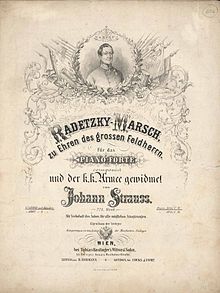
The "Radetzky March", Op. 228, (German: Radetzkymarsch; pronounced [ʁaˈdɛtskiˌmaʁʃ] ⓘ) is a march composed by Johann Strauss (Senior) which was first performed on 31 August 1848 in Vienna to celebrate the victory of the Austrian Empire under Field Marshal Joseph Radetzky von Radetz (the piece's namesake) over the Italian forces at the Battle of Custoza, during the First Italian War of Independence. It has been noted that its tone is more celebratory than martial, but nevertheless it soon became popular among regimented marching soldiers.
Origin
[edit]Strauss had already used the theme in his Jubel-Quadrille, Op. 130; the upbeat bears a considerable resemblance to the second theme from the Allegro in Joseph Haydn's Symphony No. 100 composed in 1794.[1]
For the trio, Strauss used an older folk melody called Alter Tanz aus Wien or Tinerl-Lied[2] which was originally in 3/4 time. When Radetzky came back to Vienna after winning the Battle of Custoza (1848), his soldiers were singing the then-popular song. Allegedly Strauss heard this singing and incorporated the melody, converted to 2/4 time, into the Radetzky March.[3]
Reception
[edit]
Along with the Blue Danube waltz by Johann Strauss Jr., the piece became an unofficial Austrian national anthem. In 1932 Joseph Roth published his novel Radetzky March, chronicling the decline and fall of the Austro-Hungarian Empire. Today, the theme is used in numerous promotional jingles and at major sporting events, in particular at football matches of the Austria national team.[4] Since 1896, the Radetzky has been the official presentation march of the Chilean Army's Military School of the Liberator Bernardo O'Higgins and the Paraguayan Army's Marshall Francisco Solano López Military Academy. The 1st The Queen's Dragoon Guards of the United Kingdom adopted the Radetzky March as its regimental quick march.[5]
When it was first played in front of Austrian officers, they spontaneously clapped and stamped their feet when they heard the chorus. This tradition, with quiet rhythmic clapping on the first iteration of the melody, followed by thunderous clapping on the second, is often observed when the march is played in classical music venues in an orchestral version prepared by Leopold Weninger (1879–1940).[6]
Since it was first introduced in 1946 by conductor Josef Krips during the New Year's Concert (Neujahrskonzert) of the Vienna Philharmonic[7] it is always played as a jubilant encore. It was announced in 2019 by the Vienna Philharmonic board of directors that a new version would be used that would replace the Weninger arrangement[8] in an attempt to "de-Nazify" the march.[9] The new arrangement was first performed at the New Year's Concert in 2020.
Piece parts
[edit]The Radetzky March consists of three main parts:
- The introduction: the whole orchestra plays and the brass section carries the melody.
- The first figure: played by the string section.
- At figure two: the whole orchestra plays until figure three, when it repeats back to the D.S. (first figure).
- The trio: played by the brass section, with the trumpet playing three sixteenth notes in the last bars.
- Figure five: the whole orchestra plays.
- Figure six: the whole orchestra plays and then repeats back to figure five.
- The orchestra plays until the last bar, then returns to the D.C. (beginning).
- The orchestra plays until figure three, finishing with the Fine ("end") bar— the direction is Da capo al fine (repeat from beginning up to the word Fine).
In movies and television
[edit]List of film and television works where you can hear the Radetzky march.
- The Good Soldier Schweik (1956): Heard several times.
- The Prisoner (1967–1968): Played by the Village brass band.
- Colonel Redl (1985)
- Battle Royale (2000)
- La Marche de Radetzky [fr](1994): This historical drama taken from the eponymous novel by Joseph Roth (1894-1939), depicts through the dismay of the young lieutenant von Trotta, the disintegration of the Austro-Hungarian Empire in the decade preceding 1914. This description is punctuated by cheerful notes and mocking the musical leitmotif: the Radetzky March.
- Chiro and Friends (2007): The song was used as the melody for the closing theme for the show.
- Svatojánský věneček [cz] (2015): In this Czech fairytale, one of the suitors of the princess invents a special cartridge that serves as a musical instrument and can play the Radetzky march.
- DějePIC! (2017): Czech children's comedy show about famous Czech personalities. One episode is dedicated to Marshal Radetz.
References
[edit]- ^ Hepokoski, James (1 December 2020). A Sonata Theory Handbook. Oxford University Press. ISBN 978-0-19-753683-4.
- ^ "Alter Tanz aus Wien (Tinerllied) - Noten aus dem Repertoire". Stammtischmusik Klosterneuburg. Retrieved 15 June 2023.
- ^ "Alter Tanz aus Wien (Tinerllied) – Noten aus dem Repertoire". www.stammtischmusik.at. Retrieved 14 June 2019.
- ^ "Radetzky Marsch – Austria-Montenegro football". YouTube. Archived from the original on 21 December 2021. Retrieved 16 June 2019.
- ^ "1st The Queens Dragoon Guards (Welsh Cavalry)". Retrieved 14 June 2019.
- ^ "Philharmonic Version of the Radetzky March". Wiener Philharmoniker. 12 December 2019. Retrieved 15 June 2023.
- ^ "New Year's Day Concert". BBC. Retrieved 16 June 2019.
- ^ Clarke, Kevin (31 December 2019). "De-Nazifying The "Radetzky March" At The 2020 Vienna New Year's Concert". Retrieved 10 January 2021.
- ^ "Wiener Philharmoniker bereinigen Neujahrskonzert von Nazi-Vergangenheit" (in German). Neue Osnabrücker Zeitung. 12 December 2019. Retrieved 3 April 2024.
Sources
[edit]- Jeroen H.C. Tempelman, "On the Radetzky March", Vienna Music, no. 99 (Summer 2000), pp. 12–13
External links
[edit]- "Radetzky March" Complete orchestral score: Scores at the International Music Score Library Project
- "Radetzkymarsch". Liedertafel. Archived from the original (mp3pro, 1.24 MB) on 28 September 2006.
- Alter Tanz aus Wien, a Radetzkymarsch trio adaptation (sheet music)
